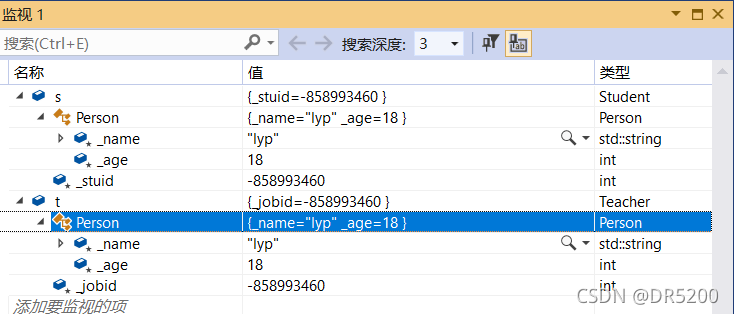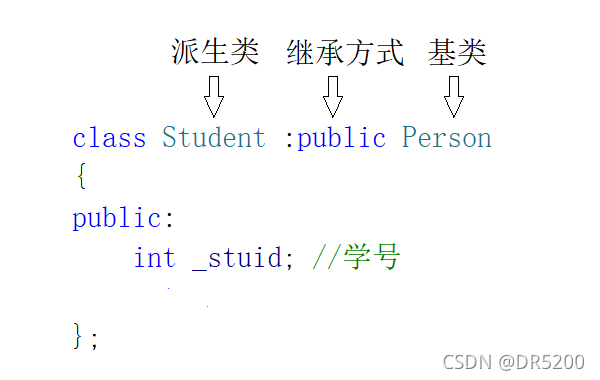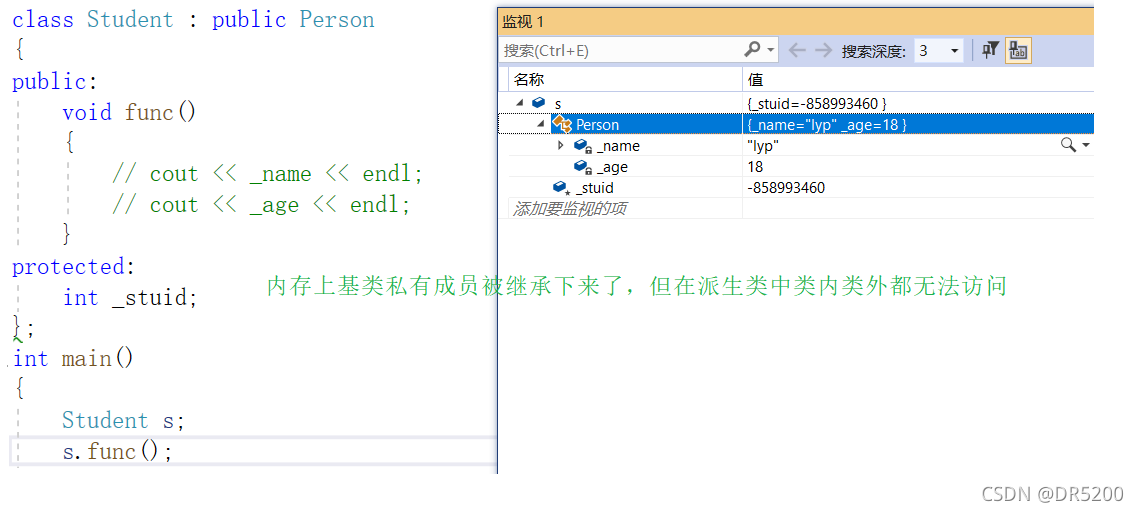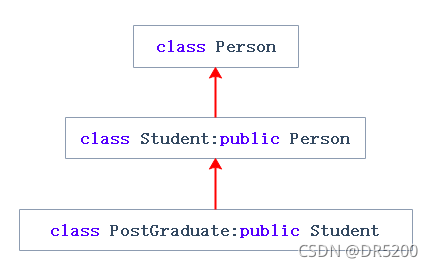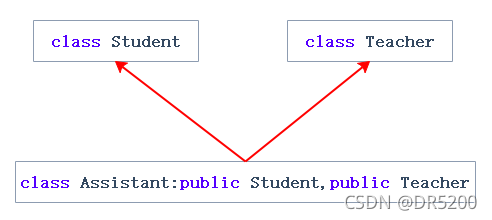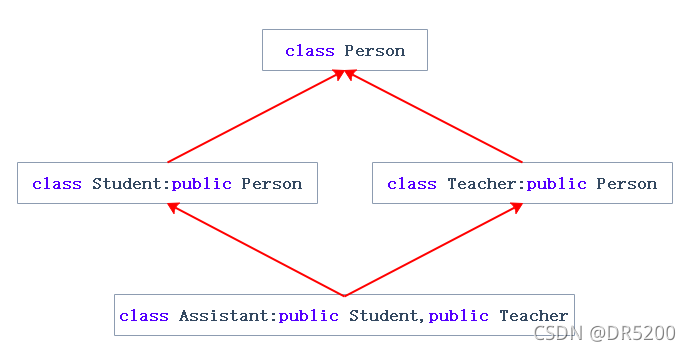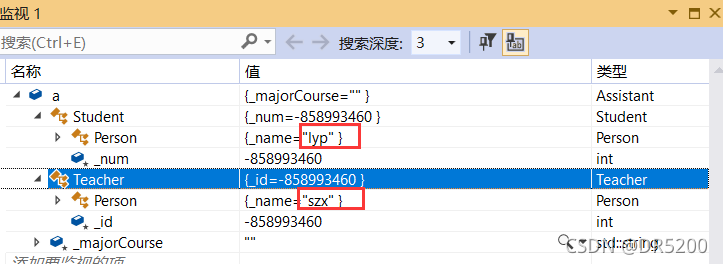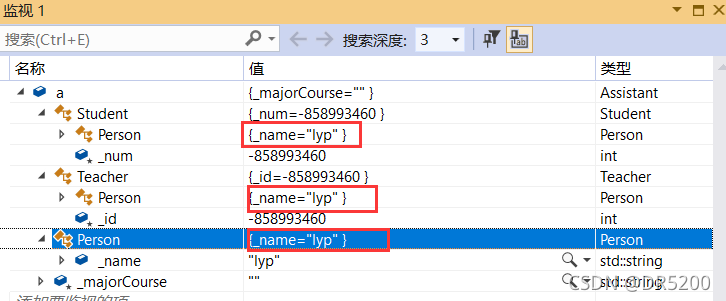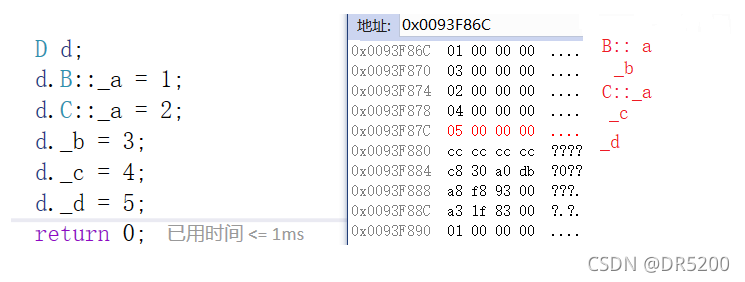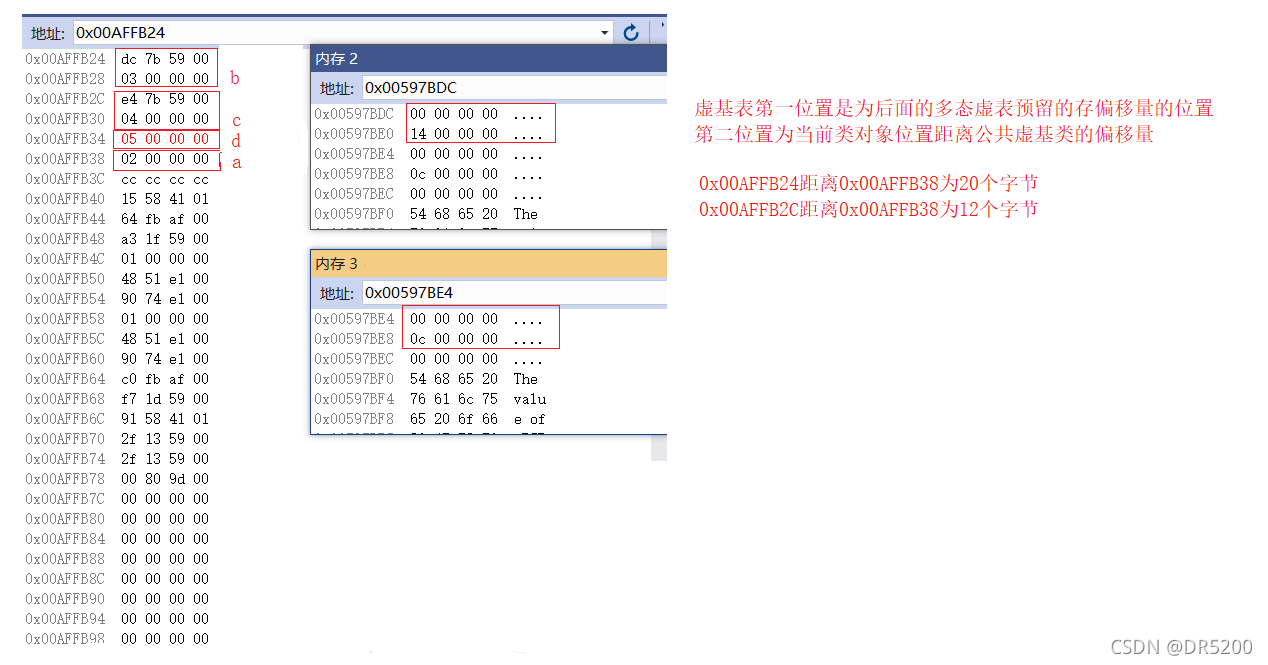文章目录
一.继承的概念和定义
继承(inheritance)机制是面向对象程序设计使代码可以复用的最重要的手段,它允许程序员在保持原有类特性的基础上进行扩展,增加功能,这样产生新的类,称派生类。继承呈现了面向对象程序设计的层次结构,体现了由简单到复杂的认知过程。以前我们接触的复用都是函数复用,继承是类设计层次的复用。
#include<iostream>
#include<string>
using namespace std;
class Person
{
public:
void Print()
{
cout << _name << endl;
cout << _age << endl;
}
protected:
string _name = "lyp";
int _age = 18;
};
// 继承后父类的Person的成员(成员函数+成员变量)都会变成子类的一部分。这里体现出了Student和
//Teacher复用了Person的成员。下面我们使用监视窗口查看Student和Teacher对象,可以看到变量的复用。
//调用Print可以看到成员函数的复用。
class Student : public Person
{
protected:
int _stuid;
};
class Teacher : public Person
{
protected:
int _jobid;
};
int main()
{
Student s;
Teacher t;
s.Print();
t.Print();
}
定义格式 :
class 派生类 : 继承方式 基类
继承基类成员访问方式的变化 :
(1). 基类private成员在派生类中无论以什么方式继承都是不可见的。这里的不可见是指基类的私有成员还是被继承到了派生类对象中,但是语法上限制派生类对象不管在类里面还是类外面都不能去访问它。
#include<iostream>
using namespace std;
class Person
{
public:
void Print()
{
cout << _name << endl;
cout << _age << endl;
}
private:
string _name = "lyp";
int _age = 18;
};
class Student : public Person
{
public:
void func()
{
cout << _name << endl;
cout << _age << endl;
}
protected:
int _stuid;
};
int main()
{
Student s;
s.func(); // 在类内也无法访问
s.Print(); // 在派生类中不可见,使用父类的接口可以访问
}
(2). 基类private成员在派生类中是不能被访问,如果基类成员不想在类外直接被访问,但需要在派生类中能访问,就定义为protected。可以看出保护成员限定符是因继承才出现的。
(3). 实际上面的表格我们进行一下总结会发现,基类的私有成员在子类都是不可见。基类的其他成员在子类的访问方式 == Min(成员在基类的访问限定符,继承方式),public > protected > private。
(4). 使用关键字class时默认的继承方式是private,使用struct时默认的继承方式是public,不过最好显示的写出继承方式。
(5). 在实际运用中一般使用都是public继承,几乎很少使用protetced/private继承,也不提倡使用
protetced/private继承,因为protetced/private继承下来的成员都只能在派生类的类里面使用,实际中扩展维护性不强。
二.基类和派生类对象赋值转换
(1). 派生类对象 可以赋值给 基类的对象 / 基类的指针 / 基类的引用。这里有个形象的说法叫切片或者切割。寓意把派生类中父类那部分切来赋值过去。
(2). 基类对象不能赋值给派生类对象
#include<iostream>
#include<string>
using namespace std;
class Person
{
public:
string _name;
int _age;
};
class Student : public Person
{
public:
int _stuid;
};
int main()
{
Person p;
Student s;
s._name = "lyp";
s._age = 18;
p = s;
// s = p; // 错误,基类对象不能赋值给派生类对象
cout << p._name << " " << p._age << endl;
// ptr能够访问子类对象中包含的父类成员
Person* ptr = &s;
cout << ptr->_name << " " << ptr->_age << endl;
// ref是子类对象中包含的父类成员的引用
Person& ref = s;
cout << ref._name << " " << ref._age << endl;
}
三.继承中的作用域
(1). 在继承体系中基类和派生类都有独立的作用域。
(2). 子类和父类中有同名成员,子类成员将屏蔽父类对同名成员的直接访问,这种情况叫隐藏,也叫重定义。(在子类成员函数中,可以使用 基类::基类成员 显示访问),使用子类给父类赋值时,同名成员使用的是父类成员
#include<iostream>
#include<string>
using namespace std;
class Person
{
public:
string _name;
int _age = 123;
};
class Student : public Person
{
public:
void Print()
{
cout << _age << endl; // 隐藏,根据就近原则,访问子类的_age
cout << Person::_age << endl; // 加上域作用限定符访问父类的_age
}
int _age = 456;
};
int main()
{
Student s;
s.Print();
}
(3). 需要注意的是如果是成员函数的隐藏,只需要函数名相同就构成隐藏。
注意不要误认为两个函数构成重载,因为两个函数构成重载的前提是两个函数在同一作用域下,而fun()和fun(int i)在不同作用域下,因此两个函数构成隐藏
#include<iostream>
#include<string>
using namespace std;
class A
{
public:
void fun()
{
cout << "A fun()" << endl;
}
};
class B : public A
{
public:
void fun(int i)
{
cout << "B fun(int i)" << endl;
}
};
int main()
{
B b;
b.fun(10);
b.A::fun(); // 加上域作用限定符访问父类的fun()函数
}
(4). 注意在实际中在继承体系里面最好不要定义同名的成员。
四.派生类的默认成员函数
(1). 派生类的构造函数必须调用基类的构造函数初始化基类的那一部分成员。如果基类没有默认的构造函数,则必须在派生类构造函数的初始化列表阶段显示调用。
Person(const char* name = "lyp")
: _name(name)
{
cout << "Person()" << endl;
}
Student(const char* name, int age)
:Person(name) // 调用基类构造函数初始化子类继承自父类的成员
,_age(age) // 自己的数据自己处理
{
cout << "Student()" << endl;
}
(2). 派生类的拷贝构造函数必须调用基类的拷贝构造完成基类的拷贝初始化。
Person(const Person& p)
: _name(p._name)
{
cout << "Person(const Person& p)" << endl;
}
Student(const Student& s)
:Person(s) // 调用基类的拷贝构造完成构造子类继承自父类的成员
,_age(s._age) // 自己的数据自己处理
{
cout << "Student(const Student& s)" << endl;
}
(3). 派生类的operator=必须要调用基类的operator=完成基类的复制。
Person& operator=(const Person& p)
{
cout << "Person& operator=(const Person& p)" << endl;
if (this != &p)
_name = p._name;
return *this;
}
Student& operator=(const Student& s)
{
if (this != &s)
{
Person::operator=(s);
_age = s._age;
}
cout << "Student& operator=(const Student& s)" << endl;
return *this;
}
(4). 派生类的析构函数会在被调用完成后自动调用基类的析构函数清理基类成员。因为这样才能保证派生类对象先清理派生类成员再清理基类成员的顺序(不需要我们自己显示的去调用,和构造函数,拷贝构造函数,赋值运算符重载不一样)。
~Student()
{
//Person::~Person(); 不需要自己显示调用父类析构
// 清理自己的 ....
// 父类析构和子类析构构成隐藏,因为后面多态的原因,任何类的析构函数的名称都会统一处理成destructor(),所以需要加上 Person::
cout << "~Student()" << endl;
// 为了保证析构时,保持先子再父的顺序析构,子类析构函数完成后,会自动调用父类析构函数
}
(5). 派生类对象初始化先调用基类构造再调派生类构造。
(6). 派生类对象析构清理先调用派生类析构再调基类的析构。
(7). 让一个类不能被继承,将其构造函数设置为私有,因为派生类对象初始化先调用基类构造再调派生类构造,而基类构造函数是私有的,在子类是不可见的。
#include<iostream>
using namespace std;
class A
{
private:
A()
{}
};
class B : public A
{
};
int main()
{
B b; // 报错
}
五.继承和友元
友元关系不能继承,也就是说基类友元不能访问子类私有和保护成员
class Person
{
public:
friend void Display(const Person& p, const Student& s);
protected:
string _name; // 姓名
};
class Student : public Person
{
protected:
int _stuid; // 学号
};
void Display(const Person& p, const Student& s)
{
cout << p._name << endl;
cout << s._stuid << endl; // 报错,友元关系并没有被继承下来,不能访问保护或私有成员
}
int main()
{
Person p;
Student s;
Display(p, s);
}
六.继承与静态成员
基类定义了static静态成员,则整个继承体系里面只有一个这样的成员。无论派生出多少个子类,都只有一个static成员实例。
class Person
{
public :
Person ()
{
++ _count ;
}
protected :
string _name ; // 姓名
public :
static int _count; // 统计人的个数。
};
int Person :: _count = 0;
class Student : public Person
{
protected :
int _stuNum ; // 学号
};
class Graduate : public Student
{
protected :
string _seminarCourse ; // 研究科目
};
void TestPerson()
{
Student s1 ;
Student s2 ;
Student s3 ;
Graduate s4 ;
cout <<" 人数 :"<< Person ::_count << endl;
Student ::_count = 0;
cout <<" 人数 :"<< Person ::_count << endl;
}
七.菱形继承及菱形虚拟继承
单继承:一个子类只有一个直接父类时称这个继承关系为单继承
多继承:一个子类有两个或以上直接父类时称这个继承关系为多继承
菱形继承:菱形继承是多继承的一种特殊情况。
菱形继承的问题:从下面的对象成员模型构造,可以看出菱形继承有数据冗余和二义性的问题。在Assistant的对象中Person成员会有两份。
class Person
{
public :
string _name ; // 姓名
};
class Student : public Person
{
protected :
int _num ; //学号
};
class Teacher : public Person
{
protected :
int _id ; // 职工编号
};
class Assistant : public Student, public Teacher
{
protected :
string _majorCourse ; // 主修课程
};
void Test ()
{
// 这样会有二义性无法明确知道访问的是哪一个
Assistant a ;
a._name = "lyp";
// 需要显示指定访问哪个父类的成员可以解决二义性问题,但是数据冗余问题无法解决
a.Student::_name = "lyp";
a.Teacher::_name = "szx";
}
虚拟继承可以解决菱形继承的二义性和数据冗余的问题。如上面的继承关系,在Student和Teacher的继承Person时使用虚拟继承,即可解决问题。需要注意的是,虚拟继承不要在其他地方去使用
class Person
{
public :
string _name ; // 姓名
};
class Student : virtual public Person
{
protected :
int _num ; //学号
};
class Teacher : virtual public Person
{
protected :
int _id ; // 职工编号
};
class Assistant : public Student, public Teacher
{
protected :
string _majorCourse ; // 主修课程
};
void Test ()
{
Assistant a ;
a._name = "lyp";
}
八.C++编译器如何通过虚继承解决数据冗余和二义性
为了方便研究,将代码简化如下,通过内存窗口来对比虚继承和非虚继承的区别
class A
{
public:
int _a;
};
class B : public A
{
public:
int _b;
};
class C : public A
{
public:
int _c;
};
class D : public B, public C
{
public:
int _d;
};
int main()
{
D d;
d.B::_a = 1;
d.C::_a = 2;
d._b = 3;
d._c = 4;
d._d = 5;
return 0;
}
可以发现非虚继承的对象内存模型分别为 B::_a,_b,C::_a,_c,_d
可以发现虚继承后,公共虚基类成员变量_a存到最下面,B,C类除了存储_b,_c外,还存储了一个指向虚基表的指针,虚基表的第二个位置存储当前类对象位置距离公共虚基类成员变量的偏移量,这样在切片时,就可以通过偏移量找到公共虚基类的成员变量
D d;
B b = d; // 通过偏移量寻找_a
C c = d; // 通过偏移量寻找_a
注意 : 虚继承后,B,C类的对象内存布局也发生了变化
九.继承和组合
class A
{
public:
void func()
{}
protected:
int _a;
};
// 继承
class B : public A
{
protected:
int _b;
};
// 组合
class C
{
public:
int _c;
A _a;
};
(1). 继承关系是一种强关联关系,B里面既可以用A公有成员,也可以用A保护成员,也就是说,A所有成员对于B都是透明的,A的改变,基本都会影响B(B和A的关联度高)
(2). 组合关系是一种弱关联关系,C里面只能用A共有成员,A的私有和保护成员对C是不透明的,A的改变对C的影响小(C和A的关联度低)
(3). 如果类之间关系更符合is-a关系,建议使用继承,如果类之间关系更符合has-a关系,建议用组合,如果既可以看作is-a关系,也可以看作has-a关系,建议使用组合(因为软件设计追求高内聚,低耦合)
